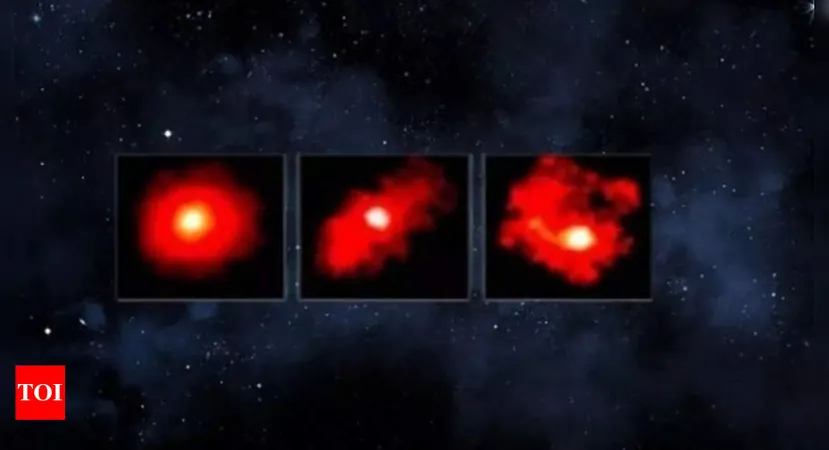
James Webb Telescope Unveils Astonishing 'Red Monster' Galaxies, Unraveling Mysteries of the Early Universe!
2024-11-18
Author: John Tan
In an extraordinary breakthrough, the James Webb Space Telescope (JWST) has identified three colossal galaxies, known as "red monsters," that are poised to revolutionize our understanding of galaxy formation. This gripping discovery reveals that these immense galaxies emerged just one billion years after the Big Bang, much earlier than previously believed.
Each of these "red monsters" boasts a mass approximately 100 billion times greater than our Sun, dwarfing earlier estimates for galaxy sizes so soon after the universe's birth. At more than 12.8 billion years old, these ancient titans probe a time when the universe was still in its infancy, during an era scientists like to call the "cosmic dawn."
What are Red Monster Galaxies?
The term "red monsters" stems from their distinct infrared glow, detectable via JWST’s Near Infrared Camera (NIRCam). This glow is the result of light being redshifted as it travels across the expanding universe, transitioning into the infrared spectrum due to the vast distance separating us from these galaxies.
Challenging Existing Theories of Galaxy Formation
Current models suggest galaxies undergo a gradual evolution, taking billions of years to reach considerable mass. However, the newly discovered red monsters defy this conventional wisdom. In a shocking revelation, they challenge the prevailing notions about the pace and conditions necessary for galaxy formation.
Stijn Wuyts, an astronomer at the University of Bath, describes them as a "tantalizing puzzle." The sheer rate at which these galaxies formed stars—approximately 80% of their gas converted into stars—far exceeds that of ordinary galaxies today, which typically convert around 20%. This unprecedented star formation efficiency prompts scientists to ask: what extraordinary conditions facilitated this rapid growth?
New Insights into Cosmic Processes
The implications of this discovery extend far beyond just galaxy size. Astronomers are now faced with critical questions regarding how such massive galaxies could form so quickly. The high efficiency of star formation points to potentially novel processes in the early universe, suggesting access to previously unknown cosmic mechanisms that enabled this rapid development.
Lead researcher Mengyuan Xiao posits that existing models of galaxy evolution need to be reevaluated. If galaxies could indeed grow more swiftly than previously acknowledged, it may indicate that the conditions in the early universe were significantly more conducive to the formation of massive structures.
The Role of JWST in Cosmic Discovery
The JWST represents a monumental leap in our capability to study the cosmos. Its exceptional infrared sensitivity allows it to detect light from galaxies that existed when the universe was still very young, providing crucial insights into their formation and evolution.
As Wuyts aptly states, "JWST is launching a new era of cosmic exploration." Its capability to peer into the farthest reaches of both space and time has already spawned a revolution in our comprehension of the universe's early chapters.
Future Explorations Await
With this groundbreaking discovery, astronomers are now eager to delve deeper into the structure and behavior of these mysterious galaxies. Future investigations, particularly through collaborative efforts using JWST alongside other telescopes like the Atacama Large Millimeter/submillimeter Array (ALMA) in Chile, will focus on unraveling the internal dynamics of these galaxies and the processes that enabled their rapid growth.
In summary, the discovery of the "red monsters" by JWST is just the tip of the iceberg in the exploration of our universe. As scientists continue to analyze these ancient galaxies, they anticipate uncovering profound insights that could reshape our understanding of cosmic history itself. The "red monster" galaxies not only challenge the established norms of galaxy formation but also beckon us to rethink everything we know about the early universe. This is just the beginning—what other cosmic secrets lie in the darkness, waiting to be unveiled?
Stay tuned as more mysteries of the universe unfold with JWST leading the charge into the unknown!



 Brasil (PT)
Brasil (PT)
 Canada (EN)
Canada (EN)
 Chile (ES)
Chile (ES)
 España (ES)
España (ES)
 France (FR)
France (FR)
 Hong Kong (EN)
Hong Kong (EN)
 Italia (IT)
Italia (IT)
 日本 (JA)
日本 (JA)
 Magyarország (HU)
Magyarország (HU)
 Norge (NO)
Norge (NO)
 Polska (PL)
Polska (PL)
 Schweiz (DE)
Schweiz (DE)
 Singapore (EN)
Singapore (EN)
 Sverige (SV)
Sverige (SV)
 Suomi (FI)
Suomi (FI)
 Türkiye (TR)
Türkiye (TR)